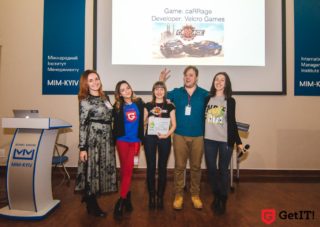Roman Semenov and Irina Ignatovich is the Co-founders of Velcro Games, maker of caRRage. By winning the GetIT! Indie Prize, Velcro Games was given the opportunity to show off caRRage at Indie Prize Berlin 2017, as part of Casual Connect Europe.


“Winning GetIT! Indie Prize and being invited to Indie Prize Berlin 2017 were big accomplishments for our team,” said Irina. “We’re thrilled to be taking part in an international exhibition of this scale. It’s a great opportunity to showcase our project, get some feedback from players, developers, and publishers, and share experience with other people who love games as much as we do. And take selfies with icons of the video game industry, of course!”
“We’ve got a lot of ideas, and we are not going to limit ourselves to a specific genre,” added Roman. “Thanks to Indie Prize Berlin 2017, we have a great opportunity to chat with representatives from various platforms and learn about the details of developing and releasing games for them. In the future, this will allow us to expand out the list of target platforms for our games.”
The Next Death Rally
caRRage is a top-down car combat game, akin to classic games of the genre like R.C. Pro-Am, Rock n’ Roll Racing and Death Rally. It’s designed to tap into not just nostalgic feelings, but also a desire for quality games of this sort on mobile.
“I think when we were kids, we must have spent more time playing games than going to school! There have been other top-down racers on mobile, but there has always been something about them that we didn’t like, and the ones we did like, we’ve already played to death. Our team even has an in-joke that we started making caRRage because we didn’t have anything to play,” said Roman. “The success of Death Rally and Mini Motor Racing (not the shooting, but the cars) shows that there’s an audience for this kind of game, but no one has made one in a long time.”
“To be honest, caRRage started out with four peaceful pets trying to push each other out of a lawn! Since we wanted to make a fast-paced, dynamic game full of eye-catching spectacles, we rejected this idea and replaced the animals with dinged-up combat vehicles. Once the early prototypes were ready, we realized that we still didn’t have enough action, so we had the idea of adding contextual shooting — not constant shooting, like in Death Rally, but more like in Rock n’ Roll Racing,” detailed Roman. “In the end, this combination of racing and combat mechanics became the foundation of the gameplay, which made every lap unique and full of surprising situations. The other modes came from over-enthusiasm — we basically wanted to stuff everything we could think of into the game.”

In order to reach this level of acclaim for a product, Irina suggested that indie developers try out their ideas, show them off early, analyze the feedback you get, do game jams, go to conferences, talk to other developers and share experiences. “Start thinking about player retention early. If you are making an F2P game, don’t put off integrating monetization until the last minute,” Roman detailed. “Game development is hard work. It demands total commitment, so the most important thing is to work a lot and believe in what you’re doing. You shouldn’t be afraid to change something or ditch it entirely, but you also have to know when to stop. I mean, you want to release the game eventually, right?”
Pimp Your Vehicle of Destruction
caRRage also has customization as one of its main features. It was done to add even more to the game and increase its replayability in the long term.

“All of the gears are more than just decorations — they also change the cars’ stats and affect the game by changing attack and defense during crashes and reducing or increasing damage from missiles, Gatling guns, Tesla guns, mines, etc,” detailed Irina. “Players get a kick out of creating one-of-a-kind cars and choosing their own colors, decals, and wheels. So creating your own unique car is also an important part of the gameplay.”
While caRRage is currently a mobile title, it’s being ported to Steam and PSN, which will take some special work. “In order to port caRRage, we need to enhance the graphics, since it’s currently optimized for mobile devices,” said Roman. “We’re going to add more effects and work on the lighting so we can take full advantage of what the PC and consoles can do. We’ve redesigned the keyboard and gamepad controls from the ground up. Our revenue model will be changed. caRRage is free-to-play on mobile, but on Steam and PSN it’ll probably be a premium game, so the balance is going to be tweaked a little.”

The Importance of Fan Testing
Testing played a huge part in making sure that all the disparate elements of caRRage worked well together. Velcro Games tried out various ideas and tested them out to see whether they would improve the game.
“We try to do internal testing during every stage of development. Unfortunately, external testing services are pretty expensive, and we aren’t always up to the task ourselves,” noted Irina. “This is where the players come in. Our fans find bugs and sometimes give us useful advice. We’re really grateful for that.”

“When we watch playtest videos, our reaction can usually be described by the question, ‘How on earth did they do that?’ And bugs, of course! During development, this has been a constant source of hilarious situations and little hysterical fits for both the players and the developers.”
Getting Everyone on the Same Page
Beyond the obvious of founding a studio to make games, Roman said it’s about something more than that. They want to make games that deliver new experiences, with stories that players experience from the perspective of the main character.
“Before founding Velcro Games, everyone on our team worked on various casual games, including farming games, runners, match-three games, and arcade games, and we also wanted to work with new technologies and genres,” said Roman. “The solution was obvious: to assemble a team of specialists, united by a common goal and project, and give them an opportunity to fully realize their professional potential and important role in game development.”
Irina says that Velcro Games above all tries to make games that the team would want to play. It helps with communication that everyone at Velcro Games has been working in an office since the beginning.
“Every team member can voice their opinion about any aspect of the game and be confident that it will be heard and appreciated,” noted Irina. “It makes sharing ideas and making corrections much easier and faster. That way, we don’t have to waste time on email and conference calls to get someone’s advice or find out how things are going. You can just walk over to an artist, look over his shoulder, and see some awesome concept art that needs to get into the game right away. We personally feel like working in an office is more productive.”
The development process for Velcro Games involves starting with an idea, talking about it, making a prototype then testing. After that, the team decides whether or not to pursue the idea and make it into a full game.
“Roman is our project leader - he’s the one who comes up with the core ideas and decides how to implement them artistically, and he makes the key decisions during the development process,” said Irina, adding, “Our first office was in an industrial area. This might have served as an inspiration when we were developing caRRage. Needless to say, we’re also inspired by other pop culture products such as movies, TV shows, and the works of famous conceptual artists.”
The Challenges of Working with an Old Version of an SDK

“We developed the game on Unity 4, which was constantly being upgraded with new features and eventually became Unity 5,” detailed Roman. “For a number of reasons, we weren’t able to switch the current project to the new version of the engine, while most third-party services and SDKs reduced or curtailed their support for Unity 4. This led to a lot of problems when it came to releasing the game and updating the content. We had to get rid of some of our services or limit their functionality because we just didn’t have the experience to carry out the new solutions we came up. We’re currently moving the project to the latest version, but having your game come out at the end of the engine’s life cycle can be a real bummer.

“The release date got pushed back significantly because our first priority was to make a game that would be fun and beautiful right out of the gate. We figured we could add monetization mechanics and worry about player retention later. We can chalk that up to our lack of experience at the time. We thought we could add essential functionality at the last minute. It ended up taking way longer than we expected, and we had to simply redo a big chunk of the game.”
Don’t Make a Game Just for Money
From the start, caRRage was designed as a free-to-play game with in-game purchases and ads, mostly because mobile publishers weren’t interested in anything else at the time. It’s complimented by a lot of the crazy customization that caRRage allows players to do, which has given artist free reign in making new designs for players to purchase and add to their vehicles.
“Just check out the gear list — the artists really let their imaginations run wild,” said Roman. “Since the beginning, we’ve been going for a kind of stylized realism — bright colors and distorted proportions let players ‘read’ the objects on the screen more quickly, which makes it easier to tell what’s going on. This style allowed our artists to develop interesting and readable silhouettes of objects and vehicles while adding a little craziness to the events in the game. Also, the idea of fast, nimble cars from a top-down perspective dictated certain conditions for us — real cars are significantly longer, which means they take longer to turn.”

Looking towards the future, Roman would like the opportunity to try and developer a different sort of game. “It’d be interesting to try our hand at making the kind of game that tells a story through gameplay. It’d probably be a game with asynchronous multiplayer where the world and characters depend on the players’ decisions and the consequences of these decisions influence events and the appearance of the game for all players. Maybe it could even tell the stories of the players who are driving around in caRRage. Why not?”
Regardless of what a game is, Roman’s concluding statement was a suggestion: “Never make a game just for money.”
Comments












